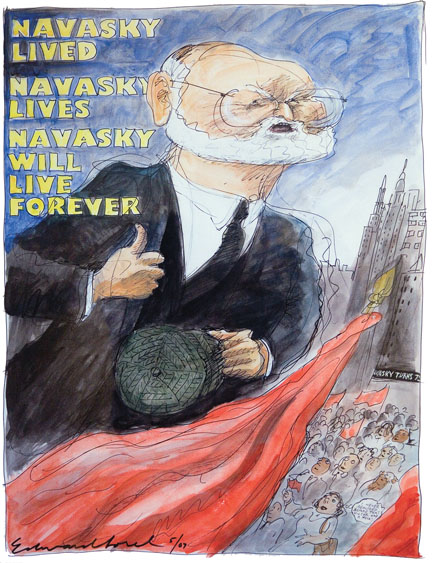The Art of Controversy

Victor Navasky by Edward Sorel
Victor Navasky is interested in controversy. He is also interested in civility.
A lover of boxing, he has a great respect for the confines of the ring—a 50-minute debate, a 500-word letter to the editor, a 5 x 5-inch box allotted for a political cartoon. He’s thinking of writing a book about political cartoons or caricatures and their peculiar impact. “I’m interested in this particular medium because it’s said to be unserious, irrelevant, inconsequential—all these adjectives when you look up the literature about them,” he says. But, in his experience, they can be more threatening than words.
In November, Navasky delivered Swarthmore’s Thomas B. McCabe Lecture on “The Art of Controversy.” (watch: Navasky's lecture)
“Caricatures in particular have a unique capacity to enrage,” Navasky said, recalling a Danish newspaper’s depiction of the Prophet Muhammad wearing a bomb as a turban.
“Ambassadors were recalled, embassies were shut down, hundreds of thousands of offended Muslims took to the streets. In Pakistan, protestors burned the Danish flag; worldwide more than 100 people were killed and 800 injured,” Navasky said.
An earlier protest at The Nation, by comparison, was mild—but still major by the magazine’s standards.
“In my more than 30 years at The Nation magazine, only once did my staff descend en masse on my office with a petition in hand, signed by 34 out of what I had thought was a staff of 32 people, demanding in advance that we not publish something.
“That something, as it happens, was a cartoon, a caricature,” Navasky recalled. It was 1984, and Henry Kissinger had released a report on the Caribbean Basin. The offending caricature, by the late David Levine, “showed Kissinger on top and the world in the form of a woman on the bottom with the Caribbean basin where her face would have been. They were in bed and Kissinger was, in Levine’s words, screwing the world.”
“The look on [Kissinger’s] face mingled self-satisfaction with ecstasy and the quintessence of evil. I told David there’s no way we can not publish it. Two-and-a-half hours later, a petition landed on my desk. Some signatories had added side comments like ‘sexist’ and ‘why isn’t he doing it to a third-world male?’” That cartoon, which Navasky went ahead and published, would later grace a catalogue cover for an art show commemorating The Nation’s 125th anniversary.
“The ultimate faith of a democracy is that through free and unfettered rational discourse good ideas will drive bad ideas out of circulation,” Navasky said. “But if the ultimate fact about art is that one image may be worth more than 10,000 words, then we’d do well to pay attention to images in general and caricatures and cartoons in particular, built as they are on stereotypes that have the power to distort and degrade and may involve archetypes that touch on the deepest questions of identity—personal, political, and cultural.”
 Email This Page
Email This Page